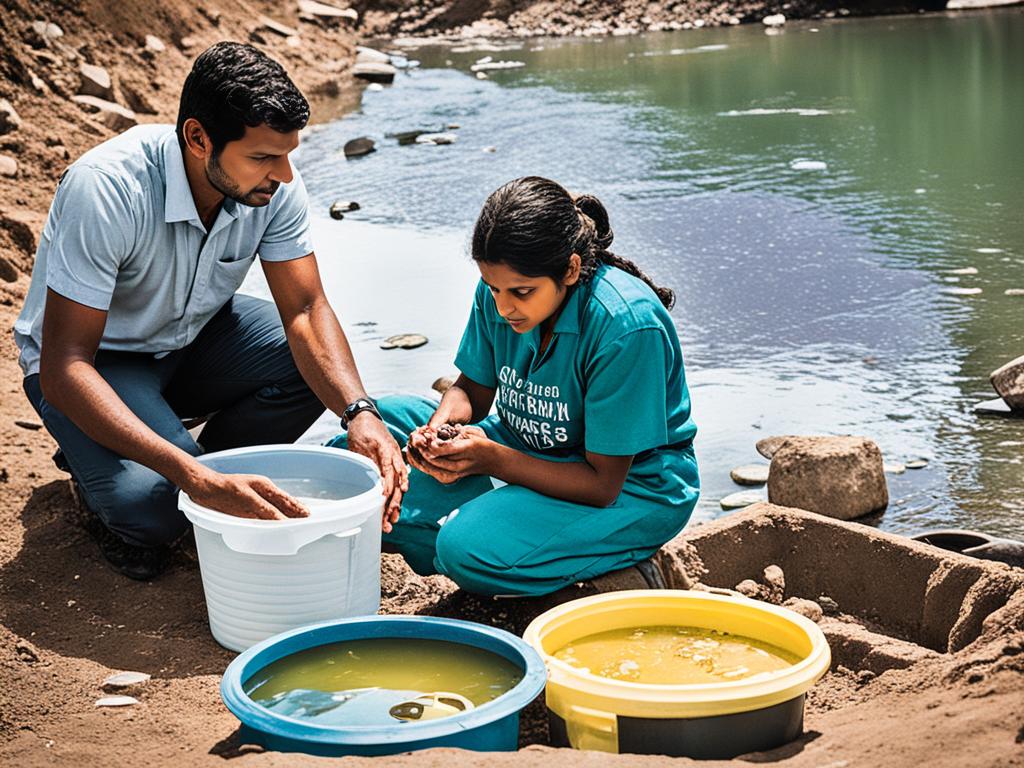
Cholera: Causes, Symptoms, Treatment and Prevention
Cholera is a severe diarrheal disease that has been a global health issue for centuries. This article will cover the details of this water-borne illness caused by Vibrio cholerae. We’ll look at the causes, symptoms, treatment, and prevention methods. This information is crucial for anyone wanting to know more about cholera and how to stay safe.

It is a serious diarrheal disease that has been around for centuries. It’s caused by the bacterium Vibrio cholerae. Additionally, we’ll discuss the causes, symptoms, treatment, and prevention methods. This information is key for anyone looking to understand cholera better and protect themselves.
Understanding Cholera: A Deadly Water-borne Disease
It is a severe illness caused by the bacterium Vibrio cholerae. It leads to quick dehydration and can be deadly if not treated. Knowing about this disease and its cause is key to fighting it worldwide.
What is Cholera?
It is a contagious illness spread through contaminated water. Initially, it starts with sudden, watery diarrhea. Moreover, it’s common in places with poor sanitation and limited access to clean water.
It can spread fast, causing outbreaks in areas that struggle to manage it.
Vibrio Cholerae: The Causative Agent
Vibrio cholerae is the germ that causes cholera. It’s a comma-shaped germ that lives in dirty water. People get it from eating or drinking contaminated food or water.
This germ spreads through contaminated water, making it important to know how to stop it. Understanding Vibrio cholerae helps us fight it more effectively.

Cholera: Symptoms and Signs
It is a serious diarrheal disease with clear symptoms that require prompt medical attention. The main symptom is a lot of watery diarrhea that resembles “rice water”. Additionally, people may experience vomiting, muscle cramps, feeling very tired, and a fast heart rate. These symptoms occur because the body loses fluids and salts rapidly.
Without treatment, severe dehydration from it can be deadly. Consequently, it can cause shock, organ failure, and even death. This occurs because the body loses too much fluid and salt.
It’s important to spot it early to get help fast. At first, patients might have these symptoms:
- Sudden, severe watery diarrhea
- Vomiting
- Muscle cramps
- Rapid heart rate
- Lethargy and weakness
These symptoms can be serious; therefore, getting medical help quickly is key. Knowing the signs helps people and doctors act swiftly to treat it and save lives.

Transmission and Risk Factors of Cholera
It is a highly contagious disease that can be deadly. It spreads mainly through contaminated water or food. Additionally, poor sanitation and lack of clean water exacerbate its spread.
Water and Food-borne Transmission
The bacteria that cause it, Vibrio cholerae, live in contaminated water. Consequently, they can spread when people drink contaminated water or eat tainted food. Moreover, in places with poor water and sanitation, like many developing countries, cholera is more common.
High-risk Areas and Populations
Some places and people are more likely to get cholera. This includes areas with lots of people, poor hygiene practices, and inadequate access to clean water or sanitation. Additionally, people with weak immune systems, such as those with HIV/AIDS, are also at higher risk.
| High-risk Areas for Cholera | High-risk Populations |
|---|---|
| Developing countries Areas with poor sanitation and limited access to clean water Regions with overcrowded living conditions | Individuals living in poverty Refugees and displaced populations People with weakened immune systems |

To fight it, we need to fix the main problems. Firstly, this means better water and sanitation. Additionally, more hygiene is crucial, and furthermore, stronger health systems are essential. Ultimately, these steps are key to reducing the harm from this disease.
Cholera Diagnosis: Confirming the Infection
Diagnosing it, is key to handling this serious disease. Specifically, it’s done by testing stool samples in a lab. Consequently, this confirms if someone has cholera.
Laboratory Tests for Cholera
Several tests help find the Vibrio cholerae bacteria in stool samples:
- Stool culture: This method grows bacteria from a stool sample to identify the Vibrio cholerae strain.
- Rapid diagnostic tests: These tests give fast results, showing cholera-specific antigens or toxins in the stool.
- Polymerase chain reaction (PCR) analysis: This method looks at the bacteria’s genes for a quick and sure way to spot Vibrio cholerae.
| Diagnostic Test | Advantages | Limitations |
|---|---|---|
| Stool culture | Highly accurate in identifying the specific strain of Vibrio cholerae | Longer turnaround time, typically 2-3 days |
| Rapid diagnostic tests | Provide quick results, often within 1 hour | May have lower sensitivity compared to stool culture or PCR |
| PCR analysis | Rapid and highly accurate in detecting the presence of Vibrio cholerae | Requires specialized laboratory equipment and expertise |
The choice of test depends on resources, urgency, and healthcare needs. Moreover, using these tests together helps confirm cholera and guide treatment and health actions.

Cholera Treatment: Rehydration and Antibiotics
Treating cholera is a two-step process. First, we restore the fluids and electrolytes lost due to severe diarrhea and vomiting. Second, antibiotics may be given to lessen the illness’s severity and length.
Oral Rehydration Therapy
Oral rehydration therapy (ORT) is key in treating it. Specifically, it involves giving a special solution of salt, sugar, and water. Importantly, this solution quickly replaces lost fluids and electrolytes, preventing dehydration and balancing the body’s chemicals.
ORT is the top choice for treating cholera. Not only is it cheap, but it is also easy to use and works well even in places with few resources. Moreover, by quickly rehydrating patients, ORT cuts down the risk of serious complications from cholera.
| Benefits of Oral Rehydration Therapy | Limitations of Oral Rehydration Therapy |
|---|---|
| Rapidly restores fluids and electrolytes Prevents dehydration and shock Can be administered in resource-limited settings Inexpensive and readily available | May not be effective for severe cases with intense vomiting Requires close monitoring to ensure proper hydration Does not directly address the underlying bacterial infection |
In some cases, antibiotics are also given to lessen the cholera infection’s severity and length. But, rehydration is the first and most important step in treating cholera and preventing serious problems.

Preventing Cholera: Sanitation and Hygiene Measures
To stop it, we need to work on sanitation, hygiene, and access to clean water. Therefore, washing hands properly, preparing food safely, and treating water can break the chain of this deadly cholera disease.
Water and Food Safety Practices
Keeping water and food safe is key to preventing cholera. Here are some important steps:
- Water Treatment: Boiling, chlorinating, or purifying water can kill the Vibrio cholerae bacteria that cause cholera.
- Proper Sanitation: Good sanitation and hygiene practices, like proper waste disposal and clean water sources, stop cholera from spreading.
- Food Safety: Good food safety means cooking food well, storing it right, and avoiding dirty foods to lower cholera risk.
Vaccination and Herd Immunity
Improving water and food safety is crucial, but vaccination campaigns also protect against cholera. In addition, vaccines help create herd immunity, making the whole community less likely to get cholera.
A full plan that includes better sanitation, hygiene, water and food safety, and vaccination can stop and control cholera outbreaks.
Conclusion
The fight against cholera, a deadly diarrheal disease, is crucial for global health. Therefore, we must understand its causes, know the signs, and use effective ways to stop it. Ultimately, this will help protect vulnerable people all over the world.
It comes from the Vibrio cholerae bacteria, which spreads quickly through dirty water and food. Therefore, spotting symptoms like severe diarrhea and dehydration early is key. This way, people can get the right medical care fast.
Having clean water, proper sanitation, and good hygiene stops cholera from spreading. Additionally, vaccines and herd immunity are vital for protecting high-risk communities. By combining research, public health actions, and community efforts, we can aim to wipe out cholera and improve health worldwide.
FAQ
What is cholera?
It is a severe illness caused by the Vibrio cholerae bacterium. It spreads through contaminated water and can cause fast dehydration. If not treated, it can be deadly.
What are the symptoms of cholera?
Symptoms include severe diarrhea, vomiting, and dehydration. People may also feel weak, have muscle cramps, and a fast heartbeat. In bad cases, diarrhea can look like “rice water.”
How is cholera transmitted?
It spreads through contaminated water or food. Poor sanitation and lack of clean water make it worse. Places with bad water and sanitation are at high risk.
How is cholera diagnosed?
Doctors test for cholera by looking for Vibrio cholerae in stool samples. They use stool culture, rapid tests, and PCR analysis for this.
How is cholera treated?
Treating it means replacing lost fluids and electrolytes. Oral rehydration therapy is key. Sometimes, antibiotics are given to lessen symptoms.
How can cholera be prevented?
Preventing it means improving sanitation and access to clean water. Washing hands, preparing food safely, and treating water help stop the disease. Vaccines are also used in high-risk areas to protect people.



This is very educative, one now know the causes, symptoms and how to prevent and treatment for cholera disease.
Nice one